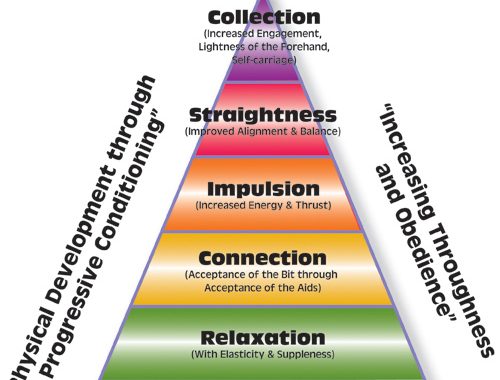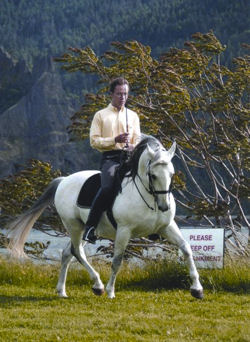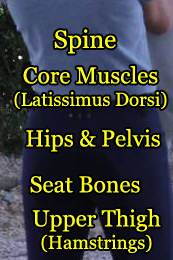What Makes a Dressage Warm-up Good?
By Jec Aristotle Ballou
 Most riders have heard about the need for a good warm-up before schooling each day. But what makes a warm-up good? Is an active one better than a slow, relaxing one? How long — or short — should it be? Many riders with good intentions hope that a period of moving their horses around either on the longe line or under saddle prior to their workout counts as suitable preparation. Unfortunately, this isn’t the case. In fact, a proper warm up governs the success of your training session. From a physiological standpoint, the warm up determines how much conditioning and positive physical response your horse will —or won’t — receive from your training. This means that since we dressage riders are aiming to make our horses stronger, fitter, and more supple every day, our pre-workout routine could either help or hinder us. This article will give you some simple tips to make your training sessions more successful, and your horse stronger day by day.
Most riders have heard about the need for a good warm-up before schooling each day. But what makes a warm-up good? Is an active one better than a slow, relaxing one? How long — or short — should it be? Many riders with good intentions hope that a period of moving their horses around either on the longe line or under saddle prior to their workout counts as suitable preparation. Unfortunately, this isn’t the case. In fact, a proper warm up governs the success of your training session. From a physiological standpoint, the warm up determines how much conditioning and positive physical response your horse will —or won’t — receive from your training. This means that since we dressage riders are aiming to make our horses stronger, fitter, and more supple every day, our pre-workout routine could either help or hinder us. This article will give you some simple tips to make your training sessions more successful, and your horse stronger day by day.
Loosening Vs. Warming
First, let’s clarify the distinction between loosening up and warming up. These are two different activities; you need to do both before your workout. The overall goal of warming up is to increase oxygen delivery and blood circulation to the horse’s skeletal muscles to prevent early accumulation of metabolic wastes such as lactic acid in the tissues. In addition to causing early fatigue, lactic acid buildup also prohibits the horse from benefiting from the workout because it changes the muscles’ pH levels, which controls their ability to contract and relax. To counter this, and to receive the benefit of exercising the muscles, you want to stimulate enough oxygen and blood flow to the horse’s muscles to peak them for performance.
Loosening up
Each day, when you first mount up or begin longeing, you should spend 3 – 5 minutes allowing your horse to walk around in a relaxed posture without any restrictive rein contact. Some choose to do this portion in-hand, others like to hack around their properties. This gentle activity allows the horse’s joint fluids to begin moving and lubricating. Studies have shown that it can take several minutes of slow movement for joint fluids to circulate fully for horses that live in mostly confined accommodations. It is important that a horse’s muscles not be in a contracted state such as a collected frame or with side reins. Joints must be allowed to move through their full range of motion prior to being held in a static position during dressage exercise with a rounded frame. There is not yet oxygen, blood flow, and fuel necessary to support the contraction – relaxation cycle that muscle fibers function with; asking muscles to engage immediately when the horse comes from his stall before these elements circulate would be essentially like choking them. In a resting state, only 15 percent of circulating blood is delivered to the horse’s muscles, traveling instead to his organs and digestive system. During exercise, however, up to 85 percent of his blood circulates to his muscles. One of the goals of loosening up is to allow this shift to happen.
Warming Up
Once you have things moving, it is time to begin the brisk activity of warming up. Here you want to begin asking the horse to stretch into contact but not be in a collected frame (see photo). Avoid the common mistake of performing suppling exercises at the start of this warm-up phase before sufficient oxygen and blood flow in the tissues and their subsequent rise in temperature gives them pliability. Cold and un-fueled muscle fibers, tendons, and ligaments are susceptible to over-stretching injuries. Also, if there is tension in an antagonistic muscle group, suppling movements will cause inefficient use of the horse’s body and contribute to side-dominance. It is best,physiologically, to spend the first five minutes of this phase with active forward movement in either trot or canter. Which gait you choose depends on each individual horse. Some are more balanced in the trot, others prefer to canter. The key here is to maintain an active gait with the goal of stimulating the skeletal muscles enough to force blood flow to them. This does not happen at a leisurely pace.
After 5 to 10 minutes of active movement, the skeletal muscles are warm enough to begin suppling exercises. These can include various sized circles, leg-yielding, turns. As this phase of warming up continues, progressively increase intensity of muscle output and suppling by using smaller circles and more difficult lateral movements. Be sure to make things more strenuous progressively. As you proceed from this stage, your warm up exercises should lead you directly into your planned workout for the day. This is to say that your warm up should flow seamlessly into your schooling session; you should not take a break after your warm up. At this point, the horse’s muscles are able to contract more powerfully, which enhances the quality of his performance and ensures a better training session. All exercises performed will now have a greater strengthening and suppling benefit.
What to Look For
Every horse should feel differently after a proper warm up period. It’s like shaking out the cobwebs every day. Learn to observe and feel your horse’s movement at the 2-minute point in your warm-up, then the 5-minute, and at the end. What changes can you detect? Things you want to feel include looseness, longer strides, more responsiveness to your aids, and physical signs that he is ready for work (i.e. his muscles are warm to touch, salivating mouth, freely swinging tail, mental focus).
Do not assume that if your horse has access to a turnout paddock he is already warmed up for you to ride. Horses in their natural state move around with short bursts of energy followed by being still. This kind of movement does not prepare their muscles and joint fluid/blood/electrolyte circulation for the kind of consistent movement and energy expenditure we require in dressage. Also remember that we need to warm up the horse specific for the kind of movements we’ll be performing, so that means he needs to be warmed up stretching through to the contact in order to exercise his back, topline, and haunches. Even if he has been in turnout, he will not do this on his own!
Below is one of my favorite warm-up patterns below, which I call “Teardrops.” (see diagram) It allows for the horse to move out in an active forward gait while also gradually bending and changing directions. It is best ridden at the trot.
After your loosening phase, develop an active rising working trot tracking to the right. Initially your horse should move energetically forward but do not expect the biggest, boldest trot he or she may be able to perform since he is not yet warmed up. As you ride the pattern a few times, strive to create that bigger trot.
- From A, proceed down the long side ensuring your horse is stretching over his topline.
- In the corner between H and C, ride a 15 -meter half circle to the right, returning to the track at K.
- Make sure you do not arrive at the track before K. The purpose is to have a long, forward line after your half -circle and not turn too quickly back to the rail.
- Proceed through the short end and down the following long side.
- In the corner between M and C, ride a 15-meter half circle to the left, returning to the track at F.
- Repeat the pattern several times.
Author: Dressage Academy
You May Also Like

The Not-So-Secret, Secret Dressage Training Formula Article
December 31, 2017
Rejuvenate Your Dressage Horse
July 6, 2017
